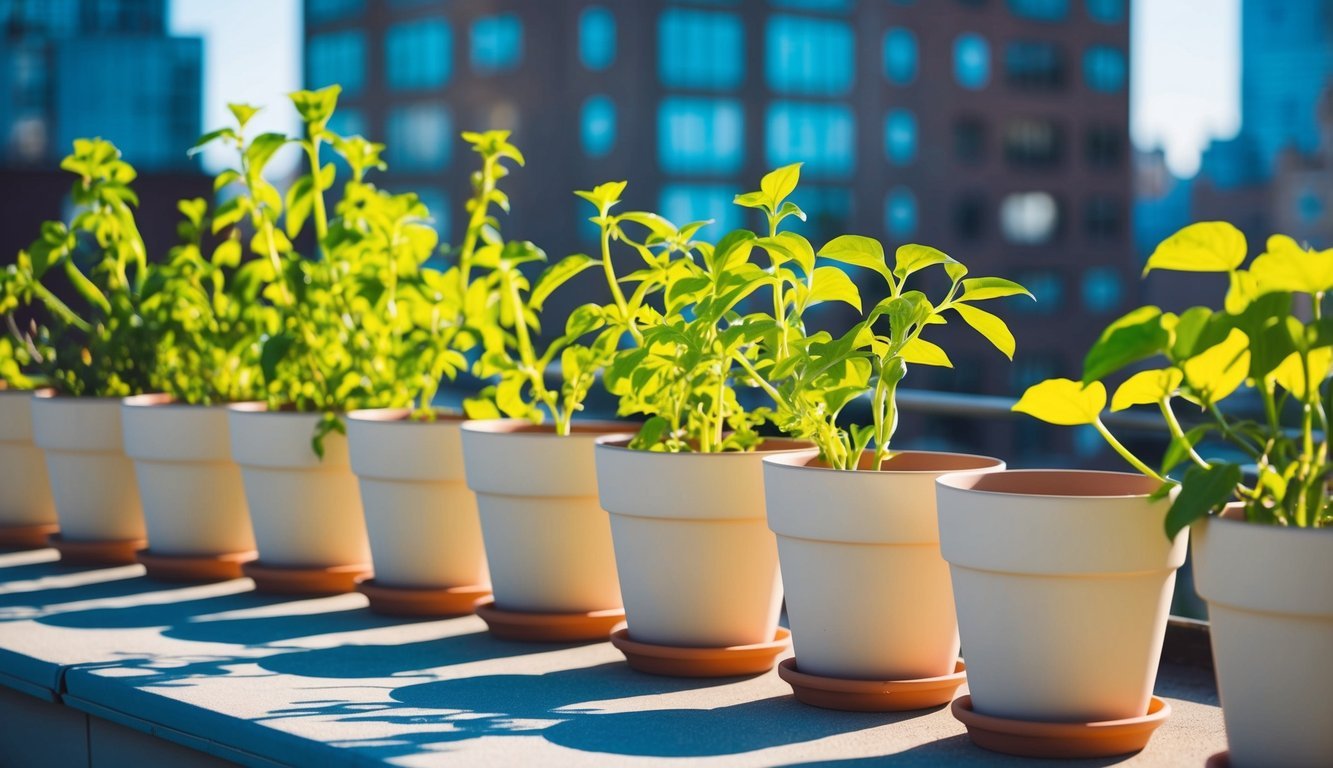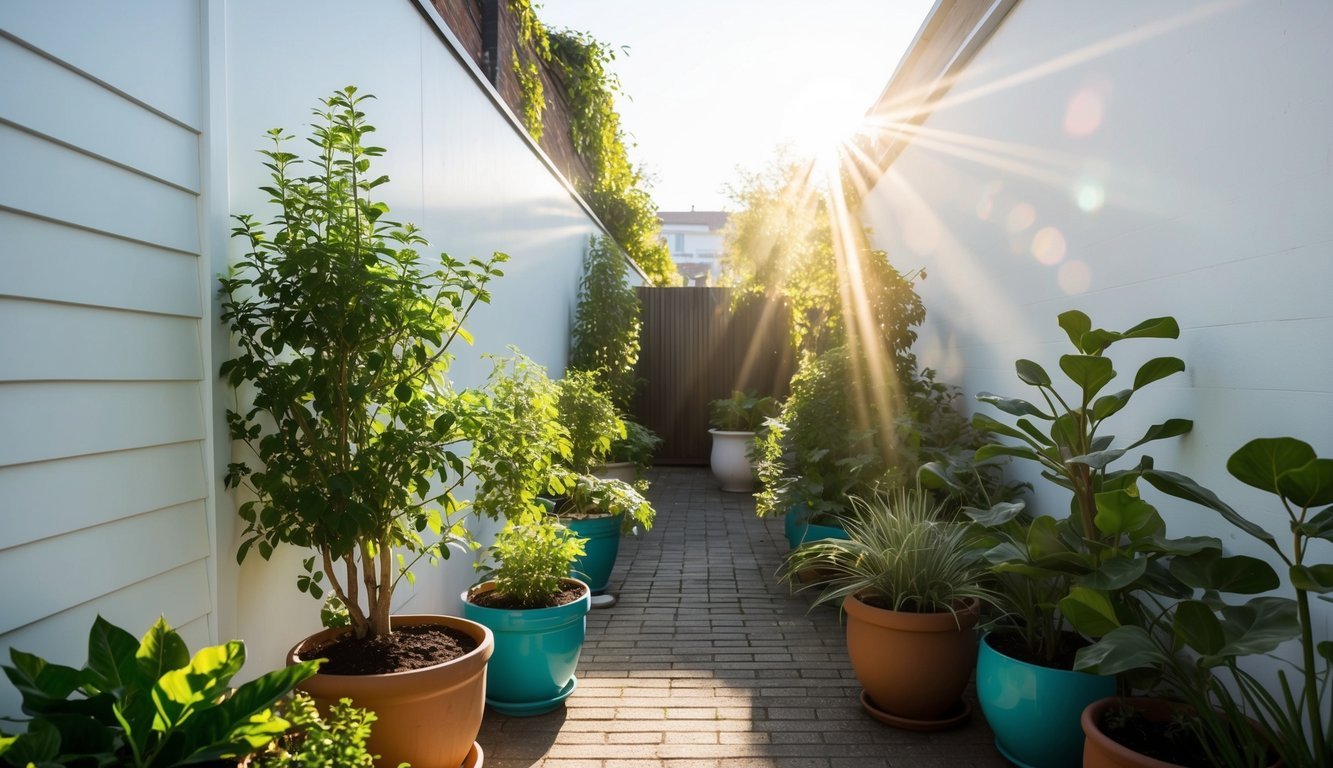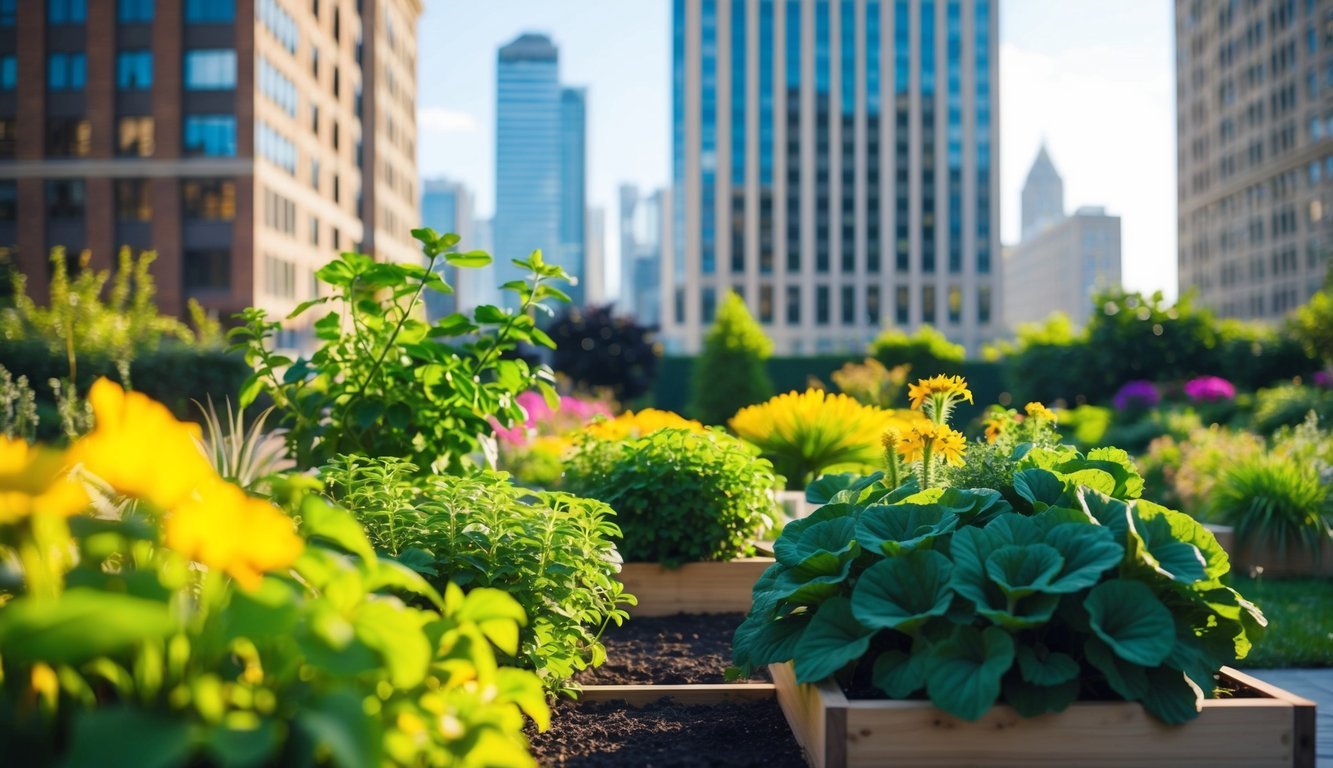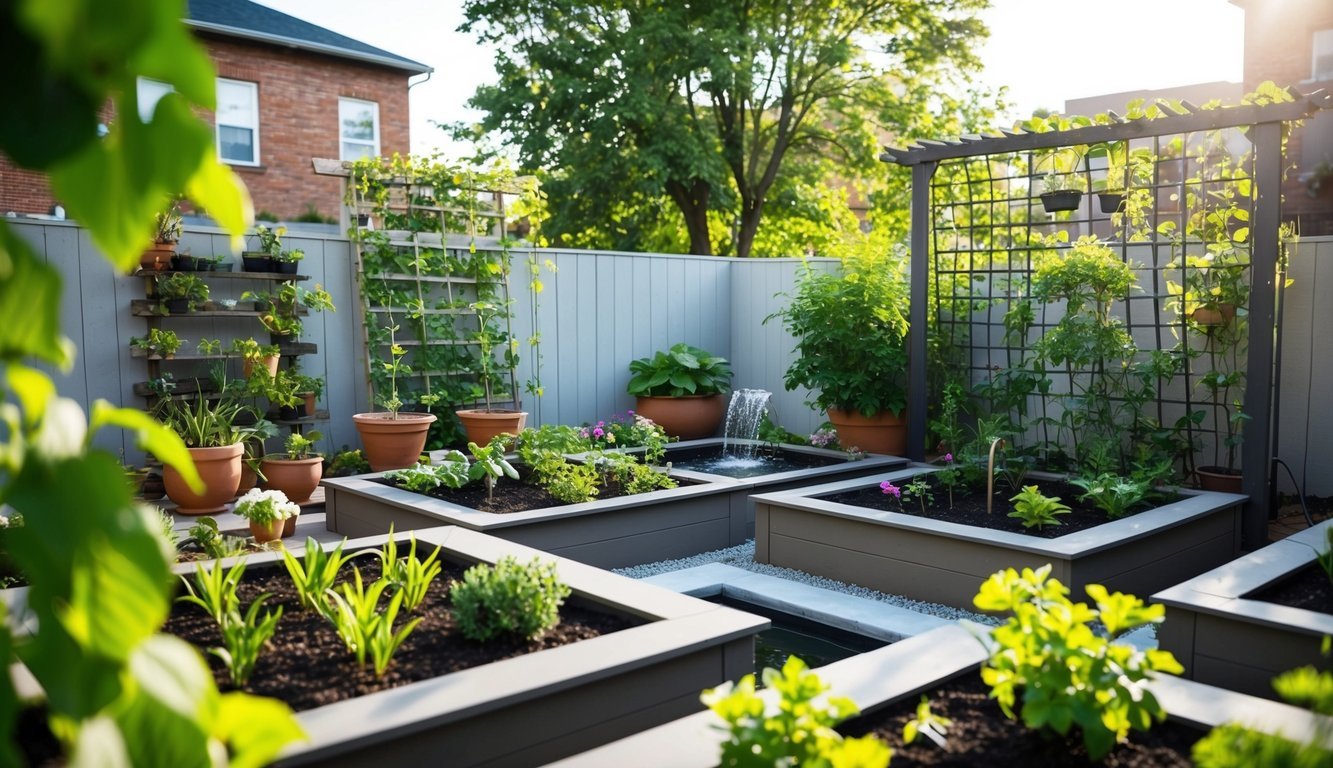Living in an urban environment presents unique challenges for gardeners, especially when it comes to sunlight.
I’ve found that finding ways to make the most of limited light can be crucial for nurturing healthy plants. With the right strategies, you can transform your small outdoor space into a vibrant garden that thrives even in the shadow of tall buildings.

I’ve explored various techniques that cater to urban gardening needs.
From choosing the ideal spot to incorporating reflective surfaces, there are plenty of tips to help enhance sunlight exposure.
The following guide will share my top ten tips for maximizing sunlight, ensuring your urban garden flourishes all year round.
1) Use south-facing windows
I’ve found that south-facing windows are a game changer for urban gardening.
They typically receive the most sunlight throughout the day, which is perfect for growing a variety of plants.
When I place my pots near these windows, I notice my plants thrive.
They get strong light that boosts growth and can even produce healthy blooms.
If you’re in a small space, like an apartment, take advantage of any south-facing areas.
It’s a simple way to maximize sunlight without needing an outdoor garden.
Make sure to monitor the temperature near these windows, especially in the summer.
Sometimes that sunlight can heat things up quite a bit.
Choosing the right plants can also make a difference.
Succulents and small herbs do particularly well when they have that direct sunlight.
It’s worth experimenting a little to see what works best in your space.
Opt for reflective surfaces
In my urban garden, I’ve found that using reflective surfaces can really boost the amount of sunlight my plants receive.
Mirrors, aluminum foil, or even white-painted surfaces can bounce light around, helping to brighten up shaded areas.
I like to place these reflective materials near my garden beds or along walls.
This way, they catch and redirect any available sunlight, which is especially helpful in tight spaces.
Sometimes, I’ll even create a DIY reflective screen using simple materials.
It’s an easy way to create a little microclimate for plants that need more light.
If you’ve got fences or walls nearby, consider giving them a coat of white paint or hanging reflective panels.
It makes a noticeable difference in how much light my plants absorb, especially during the early morning or late afternoon.
Using reflective surfaces has been a game changer for my gardening success in the city.
It’s a simple yet effective strategy for maximizing sunlight in any urban garden.
3) Choose light-colored pots

Using light-colored pots is a simple yet effective way to help my plants thrive in an urban garden.
Dark pots absorb more sunlight and heat, which can stress plants, especially in tight spaces with limited airflow.
Light-colored pots reflect sunlight, keeping the soil cooler.
This helps prevent overheating, especially on hot days.
Cooler soil can lead to healthier root systems and improved plant growth.
I also find that lighter pots can brighten my garden space.
They add a fresh, airy feel that enhances the overall aesthetic.
Plus, they often show off the vibrant colors of the plants better than darker options.
For my container choices, I consider materials like ceramic or plastic in white or pastel shades.
These not only look great but also serve a practical purpose.
Taking this simple step makes a noticeable difference in how my plants react to the urban environment.
Trim Overhanging Branches
I’ve noticed that overhanging branches can really block sunlight from reaching my plants.
Trimming these branches can make a big difference in promoting plant growth.
First, I assess which trees or shrubs are casting shadows.
It’s important to identify the areas that need more light.
Once I pinpoint the obstructive branches, I get my pruning shears ready.
For smaller branches, a simple trim will do.
But for larger limbs, I grab a saw.
It’s essential to make clean cuts to prevent any damage to the tree.
After trimming, I notice the sun pours into my garden, benefiting my plants.
The extra light not only helps with growth but also improves their overall health.
Keeping an open canopy is key to maximizing sunlight exposure in my urban garden.
5) Place mirrors strategically

I’ve found that using mirrors in my urban garden can make a big difference.
Mirrors reflect light, which helps brighten up darker areas.
By bouncing sunlight around, they can make a space feel a lot more open.
I like to place mirrors where they capture the sun’s rays during peak hours.
This can create a warm, inviting spot for my plants.
It also gives the illusion of more space, which is handy when gardening in a compact area.
Experimenting with different sizes and shapes of mirrors is fun.
A large mirror can reflect a good chunk of light, while smaller ones can add interest and depth.
Additionally, positioning mirrors to reflect greenery can enhance the aesthetic of the garden.
Just be sure to choose locations that won’t be affected by too much wind or harsh weather.
With the right placement, mirrors can really amplify the light and beauty of my urban space.
6) Set up vertical planters
I love using vertical planters in my urban garden.
They make such great use of limited space, allowing me to grow more plants without needing a larger area.
Choosing the right spot is key.
I make sure to assess the sunlight each area gets throughout the day.
Since buildings or trees often block light, I position my planters where they can soak up as much sun as possible.
I’ve found that materials like wood, metal, and even recycled containers can work well for vertical gardening.
I like to mix different plants together, which not only looks good but helps me maximize the use of my planters.
Also, I remember to keep my plants well-watered and to use quality potting soil.
A good mix will ensure proper drainage and support healthy growth.
This setup has really transformed my gardening experience, proving that even small spaces can flourish with a little creativity.
7) Embrace white walls

I’ve found that using white walls in my urban garden can make a significant difference in how much sunlight my plants receive.
Light-colored surfaces reflect sunlight, which helps brighten up shaded areas.
When planning my garden layout, I strategically placed trellises or pots close to white walls.
This setup creates a bounce effect that directs more light toward my plants.
If white walls aren’t an option, I can always paint a fence or a garden shed in a light color.
This simple change can enhance the overall light exposure in my gardening space.
I also enjoy decorating the walls with reflective materials like mirrors or light-colored decorations.
It adds a fun touch while maximizing the sun’s benefits.
In small urban gardens, every bit of light counts.
Embracing the idea of white walls has helped me create a more vibrant and successful gardening environment.
8) Install a trellis

Installing a trellis has transformed my urban garden.
It’s a simple way to create vertical space and maximize sunlight exposure.
Trellises can be used for climbing plants, allowing them to grow upward.
This helps them get more sunlight than they would if they were spread out on the ground.
When choosing a trellis, I consider the style that fits my garden.
I like to match it with the overall look of my outdoor space.
Positioning the trellis is key.
I place it in a spot that gets the most sunlight during the day.
This makes sure the climbing plants receive adequate light for healthy growth.
I’ve noticed that using a trellis not only maximizes sunlight but also adds an aesthetic element.
It really enhances the garden’s appeal by adding layers and texture.
9) Utilize roof space

Utilizing roof space is a game changer for urban gardening.
I love the idea of transforming an empty roof into a vibrant garden.
It’s a great way to maximize sunlight exposure while creating a green oasis.
Before starting, I check my roof’s ability to handle the weight of plants and containers.
Lightweight materials are key.
I often opt for smaller, lightweight pots or vertical gardening solutions.
Vertical gardens can really save space and allow more plants to thrive.
Herbs like basil and parsley do well in containers and can easily be placed on my rooftop.
I also think about sun exposure.
Finding the sunniest spots on my roof helps ensure that my plants get the light they need.
Another important factor is water drainage.
I make sure my containers have adequate drainage to prevent waterlogging, which can harm my plants.
With some creativity, my rooftop can become an enjoyable gardening space that not only looks great but is functional too.
It’s rewarding to grow plants in a spot that was once just an empty roof!
10) Select sun-loving plants

When I plan my garden, choosing the right plants is crucial.
I always look for varieties that thrive in full sun.
These plants need at least six hours of direct sunlight daily.
In my experience, vegetables like tomatoes and peppers are great sun-loving options.
They not only enjoy the heat but also produce well when given ample sunlight.
Flowers such as sunflowers and zinnias also brighten up the garden.
These blooms attract pollinators and add vibrant color.
It’s essential to consider local climate conditions.
Some sun-loving plants perform better in specific areas, so I always check what grows well in my region.
Before planting, I take note of how sunlight moves in my garden.
Identifying spots that receive the most sun helps me place my plants where they’ll thrive.
Since some plants prefer different light intensities, I pay attention to these details.
This way, I can create a flourishing garden that’s not just beautiful, but also productive.
Understanding Sunlight Dynamics

Understanding how sunlight works in an urban environment is crucial for maximizing your garden’s potential.
Recognizing the role of natural light and identifying sun patterns can significantly enhance plant growth and productivity.
The Role of Natural Light in Plant Growth
Natural light serves as the primary energy source for plants.
Plants convert sunlight into energy through photosynthesis, which fuels their growth.
Without adequate light, plants can become weak and leggy, with poor yields.
Certain plants thrive on direct sunlight, needing at least 6-8 hours of full sun daily.
Examples include tomatoes, peppers, and squash.
Conversely, shade-tolerant plants like ferns and hostas can adapt to lower light levels.
I often recommend experimenting with different plant species to find what works best in your specific conditions.
Using reflective surfaces, such as mirrors or light-colored walls, can also help direct more sunlight toward your plants.
Identifying Sun Patterns in Urban Settings
In an urban landscape, buildings and other structures can block sunlight, creating shaded areas.
To maximize light, I recommend observing your garden throughout the day and noting sun patterns.
Try this simple approach:
- Morning Light: Observe how quickly the sun rises over buildings.
- Midday: Check how long shadows are cast by structures.
- Evening: Notice the direction sunlight retreats.
This helps identify prime locations for sun-loving plants.
Utilizing vertical gardening techniques can also make good use of limited space, allowing plants to get maximum exposure.
With a little observation, you can create an optimal sunny environment for your urban garden.
Designing Your Urban Garden for Optimal Sunlight

Creating an urban garden that thrives in limited light can be a fun challenge.
A thoughtful design can make a significant difference in how much sunlight my plants receive.
Arranging Plants Based on Sunlight Needs
When arranging my plants, I prioritize their sunlight requirements.
I like to group plants with similar needs together.
For instance, sun-loving plants like tomatoes and peppers should be positioned in the brightest spots, while shade-tolerant options, such as ferns or leafy greens, can be placed in lower-light areas.
Here’s a simple layout strategy:
- Full Sun (6+ hours): Vegetables like tomatoes, beans, and herbs.
- Partial Sun (3-6 hours): Squash, lettuce, and carrots.
- Shade (less than 3 hours): Spinach and certain ornamental plants.
This approach not only helps my plants thrive but also creates a visually appealing arrangement.
Also, consider the growth heights—taller plants can shade shorter ones, so I always position them accordingly.
Using Reflective Surfaces to Boost Light Exposure
I’ve discovered that reflective surfaces can significantly enhance light exposure.
Simple elements like mirrors or metallic garden decorations can bounce sunlight back onto my plants.
I often use:
- Mirrors: These can double as decorative elements and light enhancers.
- White Walls or Fences: Painting them white or light colors reflects more light.
- Aluminum Foil: It’s a cost-effective option. I sometimes line the insides of my containers with it for extra brightness.
Incorporating these reflective surfaces into my garden setup not only increases light exposure but also adds unique design elements.
They are easy to adjust, allowing me to experiment with placement until I find what works best for my plants.

